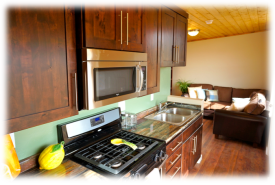Prefab, Green, AND Attractive?
 If you've spent any time on the freeways and highways of this country, you've probably seen a prefabricated home lumbering down the road with an "Oversized Load" sign. They're instantly recognizable once they're installed: ugly, squat, boring, and utterly uninspired.
If you've spent any time on the freeways and highways of this country, you've probably seen a prefabricated home lumbering down the road with an "Oversized Load" sign. They're instantly recognizable once they're installed: ugly, squat, boring, and utterly uninspired.
Pre-fab homes are changing
But all that is starting to change as high-end architects and designers embrace the prefab home, and people realize their green potential. When you manufacture homes on the site of a central location, you can cut down vastly on their environmental impacts, and not only that, you can build them more cheaply, too. Companies with a green commitment can work on the most energy-efficient homes possible and pass on substantial savings to their customers, allowing people without much money for a house still to build the green home of their dreams.
Save on labor costs
Especially in rural areas, the cost of working with contractors on site-built homes can be high, particularly when people want to use environmentally-friendly materials. Labor tends to be expensive, and so do the materials needed, especially when shipping costs are factored in. Consequently, companies working on efficient, beautiful manufactured homes have a considerable leg up in the industry.
Zip Kit Homes
Zip Kit Homes, based in Utah, is upending the idea of what a traditional prefabricated house should look like. These homes are graceful and elegant, made with quality materials that are nevertheless cost-effective to process in volume at the factory site. They're also designed with eco-friendliness in mind, including not just energy-efficient appliances but also layouts and materials that have a minimal environmental footprint.
Durability
Part of the design also includes extreme durability. For residents of earthquake-prone regions, this can be a concern. Any new construction has to be carefully considered and evaluated to determine whether it can withstand potential earthquakes as well as other weather events like storms. Zip Kit Homes has taken durability standards to heart to create extremely robust homes that will stand the test of time.
Customizable modular design
The modular design also allows for considerable configurability. This can be a significant concern with prefab housing, which tends to look the same except for colors and small surface changes. When modular designs are used, homeowners have much more control over the layout and presentation of the home, and an opportunity to make it their own. While it's not a fully custom home, it still has much more flexibility, including the ability to add modules later.
Win-win for consumers
As the consumer market for chic, environmentally-conscious prefab homes grows, so do the number of manufacturers working to meet their needs, including regionally-specific concerns, such as stout Chicago roofing for cold winters. That's a win-win for consumers, who definitely have the upper hand when it comes to their buying options. Prices are likely to fall in response to the competition, while research into materials, construction materials, and design features can only improve!
Katie Marks writes for Networx.com.
Updated September 3, 2018.
Looking for a Pro? Call us (866) 441-6648

Remodeling Average Costs
Remodeling Contractors Experiences

Don’t Be A Goober – Hire Qualified Pros For Safe Tree Removal

Tree Removal So Fast And Efficient It Didn’t Even Wake Our Newborn



